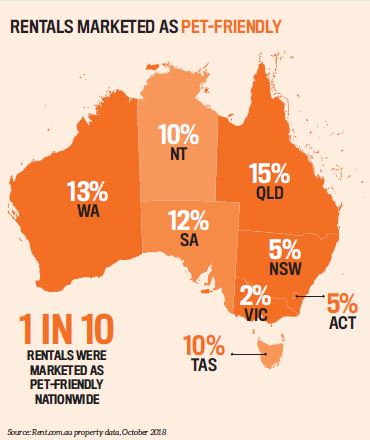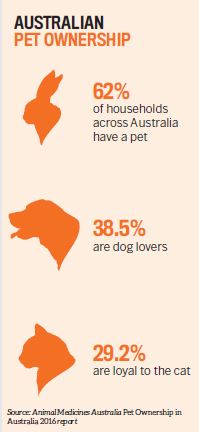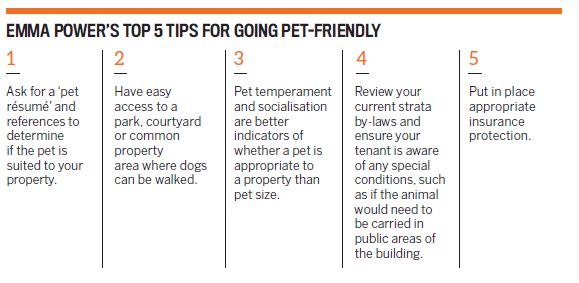Pets have settled too comfortably into the strata by-law debate, and throngs of apartment owners are siding with the culturally ingrained view that these creatures only bring mess and noise.
But as the no-petsallowed grumbles carry on, there’s also a greater shift happening, collectively driven by the rise in apartment living, people’s need for companionship, and a new age of community togetherness – all championed by the paw.
The Animal Medicines Australia Pet Ownership in Australia report in 2016 revealed that 62% of households across Australia had a pet. While 38.5% of those preferred dogs and 29.2% cats, it noted that other species such as reptiles and small mammals were also becoming used to co-existing with us. But according to the report, high-density housing in urban areas, especially multi-dwelling buildings, posed the greatest threat to pet ownership.
Coming up against reluctant landlords who believe pets could cause havoc in their properties, pet owners’ choices of possible rentals are still limited – to the point that sometimes they have to give their pets away.
In fact, according to research conducted by rent.com.au in October 2018, only 2% of rentals in Victoria were then explicitly marketed as pet-friendly, followed by 5% in NSW. Nationwide, this narrowed down to one in 10 rentals.

With demand for animal friendly properties desperate to be met, could opening your investment door to our nation’s furry companions be your next profitable move?
“Pet-friendly rentals can certainly increase the market pool,” says Nicola Parisi, head of property management at Village Property, a property management and sales agency geared towards maximising value.
“Generally, this is a good move. Moving with the times and accommodating modern lifestyles is a great way to increase enquiries and include those applications from tenants with pets that an owner would otherwise not have received.”
It’s a trend that has been closely tracked by Emma Power, senior research fellow in geography and urban studies at Western Sydney University. Having followed Australian attitudes towards pets in properties for the last 13 years and led a number of case studies, Power affirms that landlords could be handed a number of investment benefits if they choose to welcome pets.
“There’s one study from the United States that shows that people are willing to spend more for a pet-friendly property, and there’s anecdotal evidence in Australia in my research that shows that pet-friendly properties are more expensive, and that people will pay more for a property if it is petfriendly,” she says.
Power’s research also revealed that landlords could experience not just a faster turnover rate but also added security.
Pet owners have a tendency to reside in properties for longer periods than those who don’t have pets, which she suggests could be because of the “scarcity of pet-friendly properties”, made worse by the fact that most households in Australia have pets.
At the moment, while petfriendly properties are less common in the market, they can potentially give landlords that competitive edge in securing tenants. Real estate agents I’ve spoken to have also said that it’s much faster to lease a pet-friendly property because there’s consistently strong demand,” Power says.
The need for more pet-friendly abodes was noted in research conducted by Power back in February 2013, when only 2.11% of Sydney rental properties were found to be open to pets, 50.8% of postcodes had no pet-friendly properties, and 23.3% had only one.
“There’s no evidence to suggest that it has become any easier to rent with a pet. For people who are on lower incomes, it can be particularly restrictive,” she says.
Power explains that while historically couples upgraded from an apartment to a house or semi-detached when they had children, rising house prices and demand from buyers have resulted in more people choosing to live in apartments throughout their entire lifespan, even when they have children.
And many people today want to have pets, whether they’ve previously grown up with them or are working professionals seeking companionship.
If the market is to remain relevant, old misconceptions of pets in apartments need to be broken down – as seen in the 2016 review of strata regulation that went on to relax some of the stricter pet-keeping by-laws, and more currently in the rise of ‘urban village’ developments that are marketed as pet-friendly.
“Rather than saying ‘no pets at all’, it’s more productive to advertise that ‘pets are considered’. It’s about matching the pet to the property, and the tenants themselves will usually have a good sense of that,” Power says.
“Very few people would want to live in a property that is not suited for their pets because they know that it will make their pet unhappy, and it will also make their own life more difficult.”'
Play it right
If you’re convinced enough about its benefits to open up an investment property to a petfriendly market, it’s important to be aware of whether your property type and its location can accommodate a pet. Note as well that not having a house with a spacious garden won’t bump you from the list.
“A decent-sized outdoor area is always a plus, especially if the pet owner works away from home all day. Ground-floor apartments can often offer courtyards or small gardens that are ideal for having a pet,” says Parisi.
“Proximity to parks or dog parks where their dogs can socialise and exercise is important to pet owners also.”
As owners often take their pets out, they spend more time in the public areas of a building than if they didn’t have pets, creating valuable pockets of interaction between residents, according to researcher Emma Power.
“Pet owners tell me that if they get home from work and take their dog down into the shared gardens, neighbours often stop and have a chat with them as they arrive home,” Power says, reflecting on case studies.
“So there are some interesting social dynamics around dogs in particular that can contribute to a stronger sense of community amongst people who have pets, and between people who have pets and those that don’t have pets in the building.”

But just as humans can cause potential wear and tear to a property, we can’t help but wonder what a set of claws could do.
“Many insurance policies don’t cover damage caused by pets, and some have specific limits, so it’s important to ensure that there is adequate protection for damage to the property caused by pets,” says Sharon Fox-Slater, managing director at RentCover EBM, a leading insurance broking firm that has been riskguarding landlords nationwide for over 25 years.
“Some strata agreements exclude pets in premises, so it’s important that landlords check all these details before putting their pet-friendly property up for lease.”
As long as a good landlord’s insurance policy is taken up, and one that thoroughly covers pet damage, the risks to a landlord are not much different to having a property rented out to people without pets, Fox-Slater says.
“There is a perception that a tenant with pets will be a higher risk because the pets will damage the property, but the fact is that most claims for rental properties are for rent default and damage caused by the tenants themselves,” she says.
“It’s very easy to secure a landlord policy with cover for pet damage; however, many have sublimits so owners are advised to check that they have adequate cover, not just a few thousand dollars’ worth,” she says.
Emphasising that the risks don’t outweigh the financial benefits, Fox-Slater says allowing pets can be a smart investment move.
If landlords were to turn their rentals over to a petfriendly market, they would also be propelling change for a wider cause.
“We have a really high rate of animal relinquishment and euthanasia in Australia. Petrestrictive housing is contributing towards that crisis, so I think that’s something for landlords to be aware of as well,” Power says.
“For them it’s not just about the investment values; it’s also about being part of a solution potentially for that animal welfare crisis that we see in this country.”

